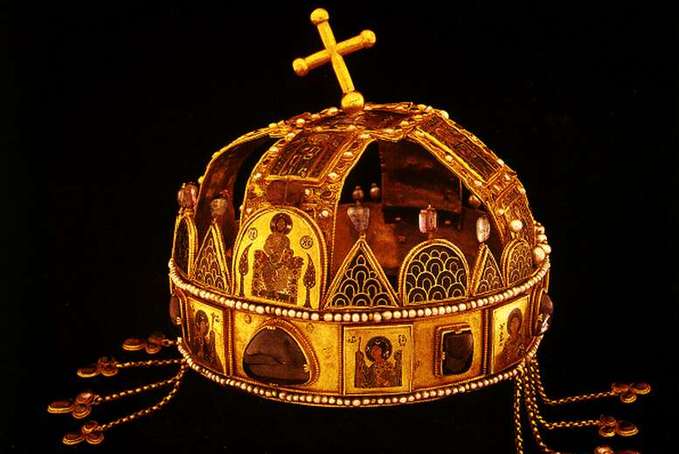The history of the Holy Crown is Hungarian history itself. The object and the idea attached to it are not identical, but their destinies are not separated, and what's more: one cannot be understood without the other.
"The Holy Crown is not a royal jewel, but the holy crown of the country, and as such, it is a symbol of the Hungarian state power... The coronation, which was initially a pure church ceremony, has become an important constitutional institution since 1205, when III. At András's coronation, he swears that he will "maintain the rights of his country and the dignity of the crown intact." Our crown is an authentic witness of our history.
Emma Bartoniek writes in her excellent book, The History of Hungarian Coronations, published in 1939:
"Let us now look at the brief history of the Hungarian Holy Crown, as this emblem is at the center of the entire Hungarian coronation practice and is a crucial and indispensable factor in the transfer of Hungarian royal power.
It is well known that our Holy Crown consists of two parts. We know that the lower, open crown was sent by the Greek emperor Mihály Dukász to the Hungarian king Géza I That this diadem was indeed a gift from Emperor Michael and indeed to Géza I is evident from the inscriptions on the pictures adorning the crown, which name both Emperor Michael and Géza, the "righteous king of Hungary (Greek: Turkia)". So no amount of skepticism can change this one iota.
The other part of our holy crown, the upper, closed crown, is adorned with a now slanted cross. This upper closed crown is what II. New Year's Eve sent to St. Stephen, which was probably combined with the Dukász open crown already in the time of Géza I. The New Year's crown donation to Saint Stephen is told in the legend edited by Bishop Hartvik King Kálmán , between 1109 and 1114. There is no reason why I would doubt its credibility, and this legend is our witness that the upper, non-Dukász part of our present-day Saint's crown is the original New Year's envoy from Saint Stephen's crown.
True, VII. A document written in 1075 by Gregory III. Henry , when he restored his Hungarian vassal Peter to his throne in 1044, sent the defeated Aba Sámuel , so that "they, as symbols of the country, would go to the place where the The principal power (principatus) over Hungary belongs«. Let's not forget that Gergely wanted to make himself lord of the chief fief of all Christian princes, including the Hungarian king. Therefore, Gergely's presentation can only be partially correct. Because let's also not forget that other fully credible German chronicles, which had no interest in telling anything but the bare facts, only know about the sending of the spear. So are the Altachi Yearbooks, which are still our most important source for the Hungarian events of this era, since our Hungarian chronicles of the same age also drew on them. And the Milanese stone, who visited Rome on behalf of his city in 1077, only saw a spear suspended in St. Peter's Basilica, and he also writes about this in his chronicle.
We believe that VII. Gregory only added the crown to the lance to support his claims as chief fief, and this crown sending has only as much basis as the papal fiefdom over Hungary, which VII. Gergely preaches with the same conviction in this letter as well as in his other writings. Besides, not even Gergely talks about the crown that Szilveszter sent - this belief could only have spread in Hungarian historiography because many people misunderstood Gergely's letter and explained that Henrik would have sent Aba Sámuel's crown to Rome because it came from there came.
On the other hand, it is a fact that III. Emperor Henrik, after his victory over Sámuel Aba (and when he also sent his spear to "St. Peter's body"), crowned Péter - "put him back in his crown with full rights" - and enthroned him with his own hand. The following year, when Henrik visited his Hungarian protégé again, he offered him his country with a spear, which Henrik obviously returned to him with the same spear - as a fief. It is also a fact that after Péter, Endré I, Béla I, and all the other XI. Hungarian kings of the 19th century were crowned (with the exception of Saint László). There was therefore a royal spear and a crown in the country even after Aba's spear went to Rome, and before Mihály Dukász presented Géza I with the lower part of our Holy Crown around 1075. (For example, King Solomon is depicted with a crown on his obules - silver coins - from 1063-1076.)
Why did Saint Stephen turn to the Pope for the crown?
Because the coronation is a church ceremony, and therefore he had to turn to the head of the Christian church for a crown. It is also a fact that on the coronation of St. Stephen, thus on the foundation of the new Hungarian kingdom III. Otto also knew, and even warmly supported it, and Saint István founded the Hungarian Christian state at the benevolent encouragement of the emperor and with the blessing of the pope. (Emphasis by me. Z. Zs.)
Which is the other and oldest Hungarian coronation badge? Even Saint Stephen is depicted on his coins with a cross in his hand, a long cross attached to a spear handle, and not a double one, but a simple Greek cross (with the same long stem). On our oldest seals - from the time of St. László and Kálmán - the king also holds a state apple, also decorated with a cross - as we mentioned above. The sword is also a tradition of Saint István's time - the still uncrowned prince who goes against the leader Koppány is knighted by his German warriors - in fact he III. He also received a spear as a gift from Emperor Otto. This spear is also often decorated with a cross. King Imre and his younger brother Endre, the later II. From Endre's quarrel, we also know how important the royal (judicial) baton is as a symbol of royal power . When King Imre crosses to Endre's camp alone from the royal side of the two armies facing each other on the banks of the Drava, he only holds his royal scepter in his hand, because this weapon is enough to take his younger brother by the hand and lead him out of his armed forces without resistance and take him prisoner .












